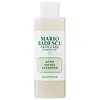What's inside
What's inside
 Key Ingredients
Key Ingredients

 Benefits
Benefits

 Concerns
Concerns

 Ingredients Side-by-side
Ingredients Side-by-side

Water
Skin ConditioningGlycerin
HumectantTriethanolamine
BufferingSodium Laureth Sulfate
CleansingPropylene Glycol
HumectantIsopropyl Alcohol
SolventSalicylic Acid
MaskingDimethicone
EmollientAloe Barbadensis Leaf Juice
Skin ConditioningChamomilla Recutita Flower Extract
MaskingThymus Vulgaris Leaf Extract
Skin ProtectingSodium Hyaluronate
HumectantCarbomer
Emulsion StabilisingParfum
MaskingDiazolidinyl Urea
PreservativeMethylparaben
PreservativePropylparaben
PreservativeBenzyl Benzoate
AntimicrobialBenzyl Salicylate
PerfumingEugenol
PerfumingLinalool
PerfumingWater, Glycerin, Triethanolamine, Sodium Laureth Sulfate, Propylene Glycol, Isopropyl Alcohol, Salicylic Acid, Dimethicone, Aloe Barbadensis Leaf Juice, Chamomilla Recutita Flower Extract, Thymus Vulgaris Leaf Extract, Sodium Hyaluronate, Carbomer, Parfum, Diazolidinyl Urea, Methylparaben, Propylparaben, Benzyl Benzoate, Benzyl Salicylate, Eugenol, Linalool
Water
Skin ConditioningGluconolactone
Skin ConditioningSodium Lauryl Glucose Carboxylate
CleansingCaprylyl/Capryl Glucoside
CleansingLauryl Glucoside
CleansingDisodium Cocoamphodiacetate
CleansingArginine
MaskingPropanediol
SolventAcrylates/C10-30 Alkyl Acrylate Crosspolymer
Emulsion StabilisingBenzyl Alcohol
PerfumingParfum
MaskingSodium Hydroxide
BufferingCoco-Glucoside
CleansingGlyceryl Oleate
EmollientSodium Benzoate
MaskingTetrasodium Glutamate Diacetate
Sodium Cocoyl Glutamate
CleansingCitric Acid
BufferingPotassium Abietoyl Hydrolyzed Soy Protein
Skin ConditioningGuar Hydroxypropyltrimonium Chloride
Skin ConditioningGlyceryl Caprylate
EmollientPolyglyceryl-6 Oleate
EmulsifyingSorbic Acid
PreservativeSodium Surfactin
CleansingGarcinia Mangostana Peel Extract
Skin ConditioningTocopherol
AntioxidantHydrogenated Palm Glycerides Citrate
EmollientLecithin
EmollientAscorbyl Palmitate
AntioxidantWater, Gluconolactone, Sodium Lauryl Glucose Carboxylate, Caprylyl/Capryl Glucoside, Lauryl Glucoside, Disodium Cocoamphodiacetate, Arginine, Propanediol, Acrylates/C10-30 Alkyl Acrylate Crosspolymer, Benzyl Alcohol, Parfum, Sodium Hydroxide, Coco-Glucoside, Glyceryl Oleate, Sodium Benzoate, Tetrasodium Glutamate Diacetate, Sodium Cocoyl Glutamate, Citric Acid, Potassium Abietoyl Hydrolyzed Soy Protein, Guar Hydroxypropyltrimonium Chloride, Glyceryl Caprylate, Polyglyceryl-6 Oleate, Sorbic Acid, Sodium Surfactin, Garcinia Mangostana Peel Extract, Tocopherol, Hydrogenated Palm Glycerides Citrate, Lecithin, Ascorbyl Palmitate
Ingredients Explained
These ingredients are found in both products.
Ingredients higher up in an ingredient list are typically present in a larger amount.
Parfum is a catch-all term for an ingredient or more that is used to give a scent to products.
Also called "fragrance", this ingredient can be a blend of hundreds of chemicals or plant oils. This means every product with "fragrance" or "parfum" in the ingredients list is a different mixture.
For instance, Habanolide is a proprietary trade name for a specific aroma chemical. When used as a fragrance ingredient in cosmetics, most aroma chemicals fall under the broad labeling category of “FRAGRANCE” or “PARFUM” according to EU and US regulations.
The term 'parfum' or 'fragrance' is not regulated in many countries. In many cases, it is up to the brand to define this term.
For instance, many brands choose to label themselves as "fragrance-free" because they are not using synthetic fragrances. However, their products may still contain ingredients such as essential oils that are considered a fragrance by INCI standards.
One example is Calendula flower extract. Calendula is an essential oil that still imparts a scent or 'fragrance'.
Depending on the blend, the ingredients in the mixture can cause allergies and sensitivities on the skin. Some ingredients that are known EU allergens include linalool and citronellol.
Parfum can also be used to mask or cover an unpleasant scent.
The bottom line is: not all fragrances/parfum/ingredients are created equally. If you are worried about fragrances, we recommend taking a closer look at an ingredient. And of course, we always recommend speaking with a professional.
Learn more about ParfumWater. It's the most common cosmetic ingredient of all. You'll usually see it at the top of ingredient lists, meaning that it makes up the largest part of the product.
So why is it so popular? Water most often acts as a solvent - this means that it helps dissolve other ingredients into the formulation.
You'll also recognize water as that liquid we all need to stay alive. If you see this, drink a glass of water. Stay hydrated!
Learn more about Water